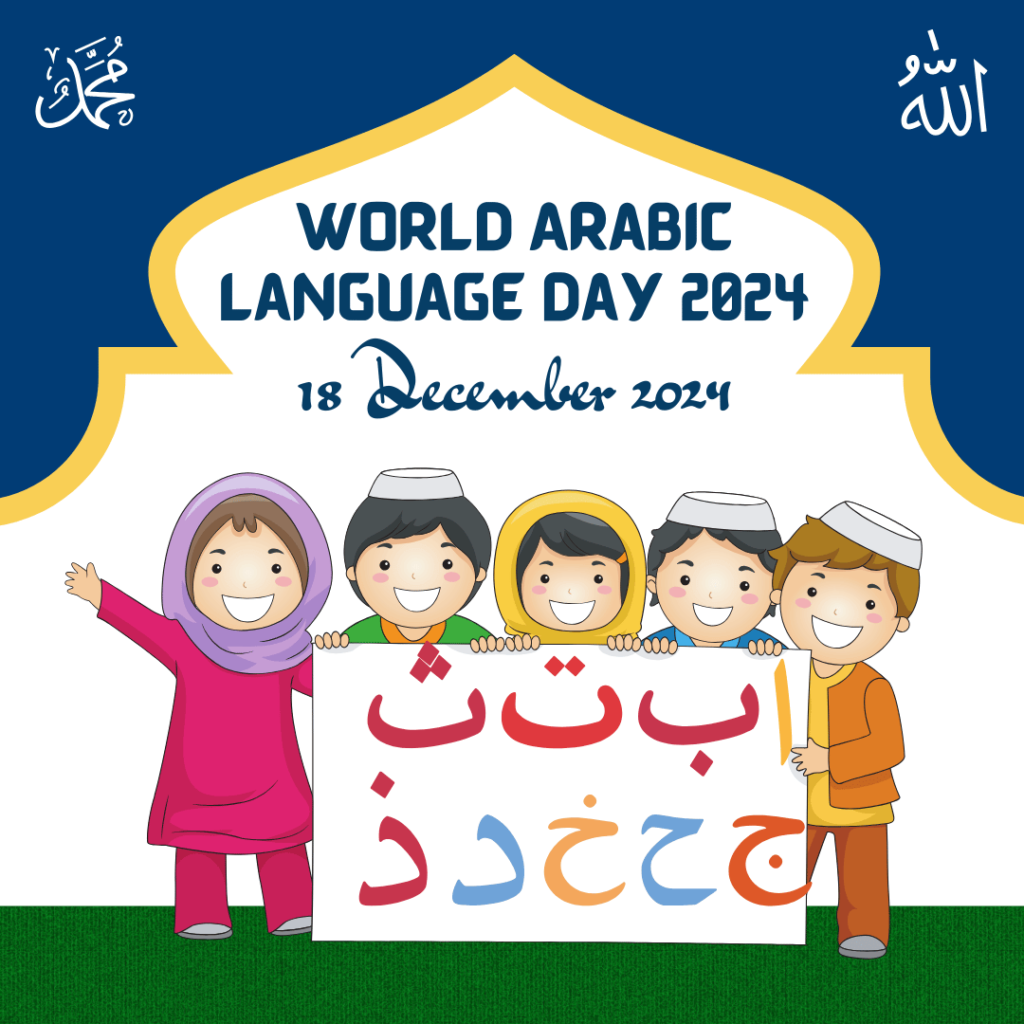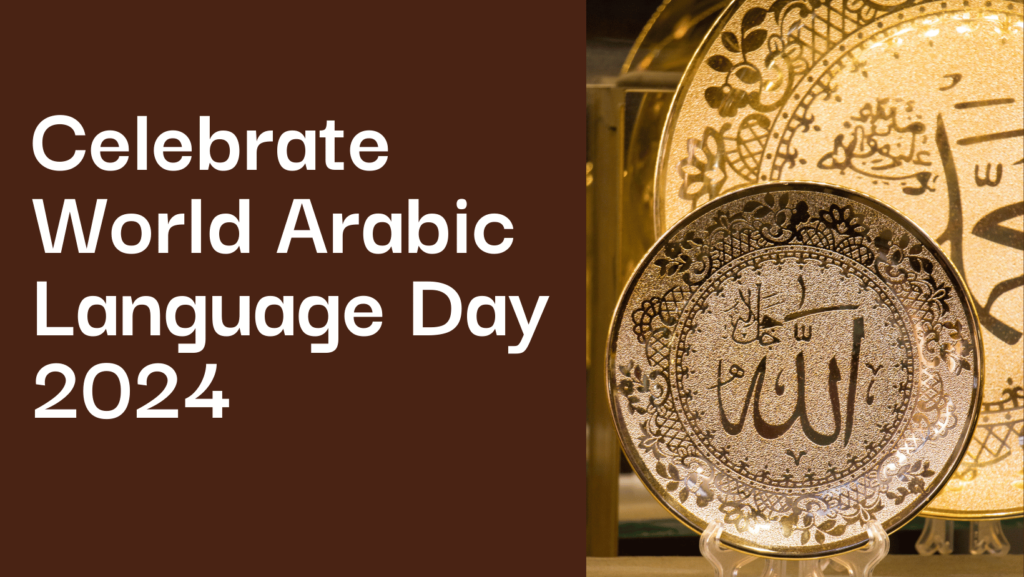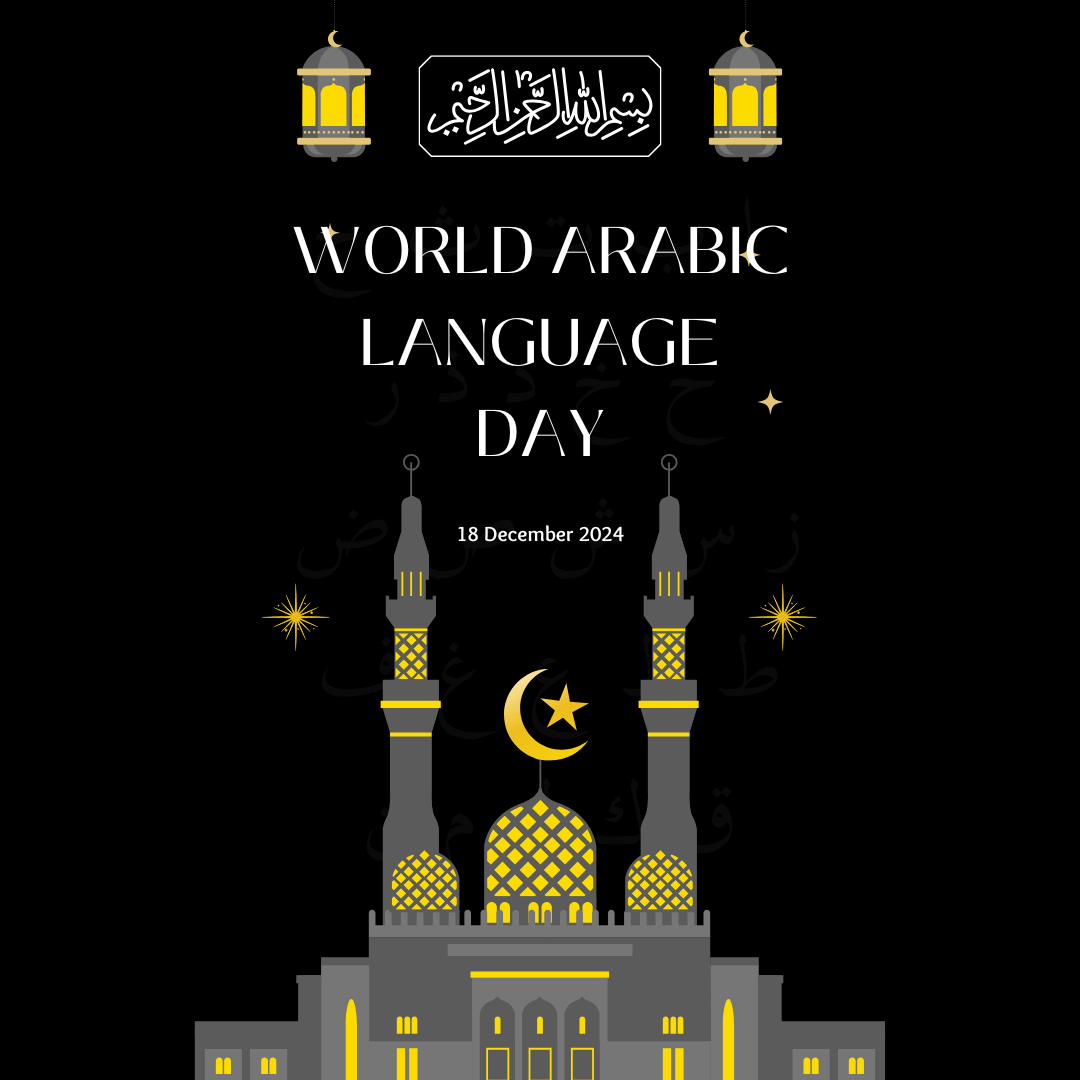When is World Arabic Language Day celebrated?
World Arabic Language Day 2024 is celebrated on Wednesday, December 18.
Also Read: International Migrants Day 2024: Theme, Date, History, Importance, Activities and Quotes
Also Read: Minorities Rights Day 2024: Date, History, Importance, Objectives, Challenges and Examples
Also Read: Monkey Day 2024: Date, History, Importance, Activities, Fun-facts and Quotes
Why is World Arabic Language Day celebrated?
World Arabic Language Day is celebrated to honor and promote the Arabic language, one of the most spoken and culturally rich languages in the world. The main reason for this day is to celebrate Arabic’s cultural value, safeguard its rich history, and promote its preservation in a globalized world. It also emphasizes the role of Arabic in fostering cultural dialogue and understanding, both within the Arab world and globally. The celebration encourages people to explore Arabic literature, art, and philosophical traditions, which have had a profound influence on various fields, from science and mathematics to architecture and poetry.
What is the theme for World Arabic Language Day 2024?
The theme for World Arabic Language Day 2024, “Arabic Language and AI – Advancing Innovation While Preserving Cultural Heritage”, highlights the intersection of technology and tradition. It focuses on the role of Arabic in artificial intelligence (AI) and how this modern technology can help preserve and promote Arabic language and culture in the digital era. This theme recognizes the growing importance of AI in shaping the future and encourages innovation in Arabic language processing, such as speech recognition, translation, and even AI-driven educational tools.
What is the history behind World Arabic Language Day celebration?
World Arabic Language Day, celebrated every year on December 18, has its roots in the United Nations’ decision to recognize Arabic as one of its official languages in 1973. The choice of this date marks a milestone in the history of the Arabic language’s international recognition and highlights its global significance. Arabic was included as one of the six official UN languages, alongside others like English, French, and Spanish, which reflected the growing importance of the Arab world on the international stage.
In 2010, UNESCO officially recognized December 18 as World Arabic Language Day. December 18 was chosen as the date for World Arabic Language Day because it marks a significant moment in the history of the Arabic language.
This observance serves to highlight the language’s role in fostering cultural dialogue and its deep ties to the Arab world’s identity and traditions. The celebration is not only about preserving the language but also about promoting its use in modern-day contexts, such as media, education, and technology.
How do people celebrate World Arabic Language Day?

World Arabic Language Day is celebrated in various creative and educational ways across the globe. The day focuses on highlighting the significance of the Arabic language, promoting its usage, and honoring its rich cultural heritage.
- Cultural Events and Performances: Many cultural institutions, universities, and embassies hold events such as poetry readings, storytelling sessions, and performances that showcase Arabic literature, music, and art.
- Educational Initiatives: Schools, universities, and language institutes organize workshops, lectures, and seminars focusing on the Arabic language.
- Social Media Campaigns: With the rise of social media, many people celebrate by sharing Arabic phrases, quotes, or poems online.
- Book Launches and Exhibitions: Libraries, bookstores, and cultural centers sometimes host exhibitions of Arabic literature, including works by prominent Arab writers.
- Media and Broadcasting: These might include documentaries on the history of the Arabic script or interviews with prominent Arabic-speaking personalities who contribute to literature, science, and culture.
- Public Discussions and Debates: In some countries, the celebration extends to discussions on the state of the Arabic language in the modern world, including its use in technology and media.
How does World Arabic Language Day promote cultural diversity?
World Arabic Language Day plays a crucial role in promoting cultural diversity by celebrating the Arabic language’s rich history, wide geographical reach, and profound impact on global culture.
- Encouraging Multilingualism and Inclusivity: This encourages societies to embrace linguistic diversity, understanding that Arabic is not just the language of one country, but a bridge to various cultures, beliefs, and historical perspectives.
- Celebrating Diverse Arabic Dialects: Arabic includes many regional dialects spoken across the Arab world, such as Levantine, Egyptian, Gulf, and Maghrebi Arabic. World Arabic Language Day celebrates this linguistic diversity, showing that each dialect has its own unique identity and cultural nuances.
- Promoting Cross-Cultural Dialogue: Arabic has been a language of science, philosophy, literature, and religion for centuries, influencing Western thought, especially during the Middle Ages when Arabic scholars preserved and expanded upon ancient knowledge.
- Encouraging the Preservation of Cultural Heritage: The day serves as a reminder of the importance of preserving languages as a form of cultural heritage.
- Highlighting Arabic’s Role in Global Communities: Arabic is a key language in various international communities, not just in the Arab world, but also in regions like North Africa, parts of Sub-Saharan Africa, and communities in the Western world.
- Bridging Generational Gaps: One of the unique aspects of World Arabic Language Day is its focus on both preserving the Arabic language and making it accessible for future generations.
What are the different forms of Arabic spoken around the world?
Arabic is a rich and diverse language, and the different forms of Arabic spoken around the world reflect its vast cultural and regional variations.
- Modern Standard Arabic (MSA): Modern Standard Arabic is the formal version of the language used in writing, news media, literature, and formal speeches.
- Classical Arabic: Classical Arabic refers to the language used in the Qur’an and other early Islamic texts. It has a highly formal structure and vocabulary that is no longer used in daily speech but remains important in religious, scholarly, and literary contexts.
- Colloquial Arabic (Dialects): The Arabic spoken in everyday life varies significantly across regions, and each Arab country has its own local dialect. Some of the most notable dialects include:
- Levantine Arabic: Spoken in countries like Lebanon, Syria, Jordan, and Palestine, this dialect is one of the most widely understood due to its prominence in popular culture and media.
- Egyptian Arabic: Commonly spoken in Egypt, this dialect is highly influential in the Arab world, especially because of Egypt’s historic role in Arab cinema and television.
- Gulf Arabic: Spoken in the Gulf region, including Saudi Arabia, the UAE, and Qatar, Gulf Arabic has its own distinctive features and vocabulary.
- Maghrebi Arabic: Spoken in North African countries like Morocco, Algeria, Tunisia, and Libya, this dialect often incorporates elements from Berber and French, making it quite different from other Arabic varieties.
- Iraqi Arabic: Unique to Iraq, this dialect blends elements from both Levantine and Gulf Arabic, and it has distinct phonetic features.
- Arabized Languages: In some regions, Arabic has influenced local languages to the point where hybrid forms of speech have emerged. For example, Chadian Arabic and Sudanese Arabic have evolved in Africa, blending local languages with Arabic vocabulary and syntax.
- Arabic in the Diaspora: Arabic has also blended with other languages in immigrant communities, creating unique forms of “Arabizi” (Arabic written using the Latin alphabet) or “Spanglish”-like varieties, which mix Arabic with English, French, or other local languages.
How many people speak Arabic globally?
Arabic is one of the most widely spoken languages in the world, with approximately 310 million native speakers. This makes it the fifth most spoken language globally, following languages like English, Mandarin, Hindi, and Spanish. Additionally, when including those who speak Arabic as a second language, the total number of Arabic speakers rises to over 420 million.
Arabic is the official language of 22 countries that are part of the Arab League, spanning from the Middle East to North Africa, and is also a key language in many other regions. Some of the most populous Arabic-speaking countries include Egypt, Algeria, Sudan, Iraq, Saudi Arabia, and Morocco.
What are some interesting facts about the Arabic language?

The Arabic language is rich in history, structure, and cultural significance, and there are several fascinating facts that highlight its unique characteristics. Following are some key facts:
- A Unique Alphabet: Arabic is written from right to left, which is the opposite of many other major world languages. It uses a script that consists of 28 letters.
- Classical and Modern Forms: Arabic has two primary forms: Classical Arabic (used in ancient texts, including the Qur’an) and Modern Standard Arabic (MSA), which is used in media, literature, and formal communication.
- Rich Vocabulary and Root System: Arabic has a root-based structure, where most words are derived from a three-letter root. For instance, the root “k-t-b” can generate words related to writing, like “kātib” (writer), “maktaba” (library), and “kitāb” (book).
- Influence on Other Languages: Many words in languages such as Spanish, Portuguese, Turkish, Urdu, and even English are borrowed from Arabic. Words like “algebra,” “alcohol,” and “zero” all have Arabic origins.
- A Language of Poetry and Prose: Arabic is deeply connected to poetry and literature. For centuries, Arabic poets were highly regarded, and classical Arabic poetry was central to the culture.
- Cultural Significance: Arabic is a language of religious significance for Muslims, as it is the language of the Qur’an and Islamic prayer and central element of identity for over 400 million.
- Arabic in Science and Mathematics: In the Middle Ages, Arabic-speaking scholars were at the forefront of advancements in mathematics, astronomy, chemistry, and medicine. This period, known as the Islamic Golden Age. Terms like “chemistry” and “alchemy” stem from Arabic.
- Multiple Dialects: While Modern Standard Arabic is used for formal communication, the dialects spoken across different Arabic-speaking countries can be so varied. For example, the dialects in Morocco, Egypt, and the Gulf region all sound distinct, despite sharing the same base language.
- Phonetic Variety: Arabic has some unique sounds that are challenging for non-native speakers, such as the ‘ع’ (Ayn), a voiced pharyngeal fricative that doesn’t have a direct equivalent in many languages.
- Arabic’s Global Reach: Beyond the Arab world, Arabic is widely spoken in diaspora communities in Europe, North America, and other parts of the globe.
How does Arabic influence other languages and cultures?
Arabic has had a profound influence on many languages and cultures, both historically and in modern times. Following are some ways in which Arabic influences other languages and cultures:
- Vocabulary Borrowing: Arabic has contributed thousands of words to other languages, especially in areas like mathematics, science, astronomy, and philosophy. Words like “algebra,” “alchemy,” “safari,” and “zero” all have Arabic origins.
- Scientific and Mathematical Influence: During the Islamic Golden Age, Arabic-speaking scholars made crucial advancements in mathematics, astronomy, and medicine. The study of algebra and chemistry owes a great deal to Arabic scholars.
- Cultural Exchange: Arabic culture has influenced music, architecture, literature, and art around the world. Arabic poetry and storytelling traditions, such as the famous “One Thousand and One Nights” (Arabian Nights), have influenced literary works across the globe.
- Religious Influence: As the language of the Qur’an, Arabic holds immense importance for Muslims worldwide. Even people who speak different languages will often learn to recite the Qur’an in Arabic, regardless of their native tongue.
- Language Evolution: For example, Maghrebi Arabic in North Africa has a distinctive sound influenced by Berber and French, while Levantine Arabic is spoken in countries like Syria and Lebanon and has been influenced by Turkish and French.
- Impact on Modern Culture and Media: Arabic continues to influence global media and culture. Many international media outlets, such as Al Jazeera, broadcast in Arabic, and this helps spread Arab culture and viewpoints to a global audience.
- Philosophy and Education: The Arabic language played a key role in preserving and transmitting the works of ancient Greek philosophers. Thinkers like Avicenna and Averroes translated Aristotle’s works into Arabic, keeping them alive for future generations.
What role does Arabic play in religion and literature?
Arabic plays a significant role in both religion and literature, influencing spiritual practices and shaping the development of literary traditions across the world. Following is how:
Arabic in Religion
- Language of the Qur’an: Arabic is the sacred language of Islam, as the Qur’an, the holy book of Muslims, was revealed in Arabic.
- Religious Practices: Muslims all over the world recite prayers in Arabic, which has helped preserve the language across different cultures. Arabic also plays a key role in Islamic scholarship, where classical Arabic is used to study Islamic law (Sharia), theology, and philosophy.
- Influence Beyond Islam: Although Arabic is primarily associated with Islam, the language also holds historical significance for Judaism and Christianity. Arabic translations of religious texts have been important in these faiths, particularly among Arabic-speaking Christian communities.
Arabic in Literature
- Classical Arabic Literature: Arabic has a rich tradition of classical literature, which includes poetry, prose, and philosophical works. Arab poets such as Imru’ al-Qais and Al-Mutanabbi shaped the poetic forms.
- The Arabic Literary Golden Age: The Islamic Golden Age (8th to 14th century) saw the flourishing of Arabic literature, with the translation movement making Greek, Persian, and Indian texts available in Arabic. Scholars such as Ibn Sina and Al-Farabi wrote influential works in Arabic.
- Modern Arabic Literature: Arabic literature has evolved, with writers such as Naguib Mahfouz, the first Arab to win the Nobel Prize in Literature, bringing Arabic literary traditions to the global stage.
- Poetry as a Cultural Force: Poetry remains one of the most important forms of expression in Arab culture. The Diwan (collection of poems) has long been a crucial part of Arab intellectual history and identity.
How is Modern Standard Arabic different from Classical Arabic?
Modern Standard Arabic (MSA) and Classical Arabic are two forms of the Arabic language, and while they share common roots, they differ in several important ways, especially in terms of usage, grammar, and style.
1. Historical Context and Usage
- Classical Arabic is the language of early Islamic texts, including the Qur’an, Hadith, and other ancient Islamic literature.
- Modern Standard Arabic is used in media, news broadcasts, formal writing, academic settings, and literature across the Arab world. It’s standardized across all Arabic-speaking countries, although regional dialects vary significantly.
2. Grammar and Vocabulary
- Classical Arabic has a more complex grammatical structure, including a more intricate system of verb conjugation and noun declensions.
- Modern Standard Arabic has simplified some of the grammatical structures, making it easier to use for contemporary purposes. For example, it has largely moved away from the dual forms, and the noun case system is simplified, especially in spoken or non-formal contexts.
3. Syntax and Style
- Classical Arabic tends to have a more elevated and ornate style, with complex sentence structures and frequent use of rhetorical devices, including metaphors, allusions, and proverbs. Its poetic nature is often reflected in the texts.
- Modern Standard Arabic tends to be more straightforward and clear, with an emphasis on accessibility. It is less elaborate than Classical Arabic, making it more suitable for everyday communication, media, and education.
4. Influence of Other Languages
- Over time, Modern Standard Arabic has incorporated new vocabulary to reflect modern concepts, technological advancements, and global cultural changes.
- Classical Arabic, on the other hand, remains more rooted in its traditional vocabulary, maintaining terms that were common in the 7th century.
5. Use in Daily Life
- Classical Arabic is typically not spoken in everyday conversations. It’s used primarily in religious contexts, classical literature, and historical study.
- Modern Standard Arabic, while still formal, is more commonly used in everyday formal settings, media, literature, and international communication between Arabic-speaking people.
6. Regional Dialects
- In contrast to Classical Arabic or Modern Standard Arabic, which are consistent across the Arab world, regional dialects (like Egyptian Arabic, Levantine Arabic, or Gulf Arabic) are used in everyday conversation.
What are some best Quotes for World Arabic Language Day 2024?
Following are the best and inspiring quotes for World Arabic Language Day 2024:
- Arabic is not just a language; it’s a gateway to an ancient culture, a living history, and a bridge between civilizations.
- Through the Arabic language, we share the timeless beauty of poetry, philosophy, and faith that has inspired generations.
- Arabic is the thread that connects the past to the present, keeping our cultural heritage alive in a changing world.
- In every word of Arabic, there’s a world of wisdom, a depth of thought, and a richness that touches the soul.
- Language is the heartbeat of culture, and Arabic’s rhythm has echoed through centuries, uniting people across borders.
- The Arabic language, like its script, weaves a tapestry of connection, creating bonds between history, culture, and the future.
- Arabic is not only a tool for communication, but a treasure trove of knowledge, art, and identity for millions around the globe.
- As we embrace Arabic in the digital age, we must also honor its legacy, ensuring it thrives while respecting its roots.
- Arabic, a language of beauty, art, and intellect, speaks to the heart and mind, binding generations across time and space.
- Let the words of Arabic remind us that culture, like language, is a living, evolving entity that reflects who we are and where we come from.


